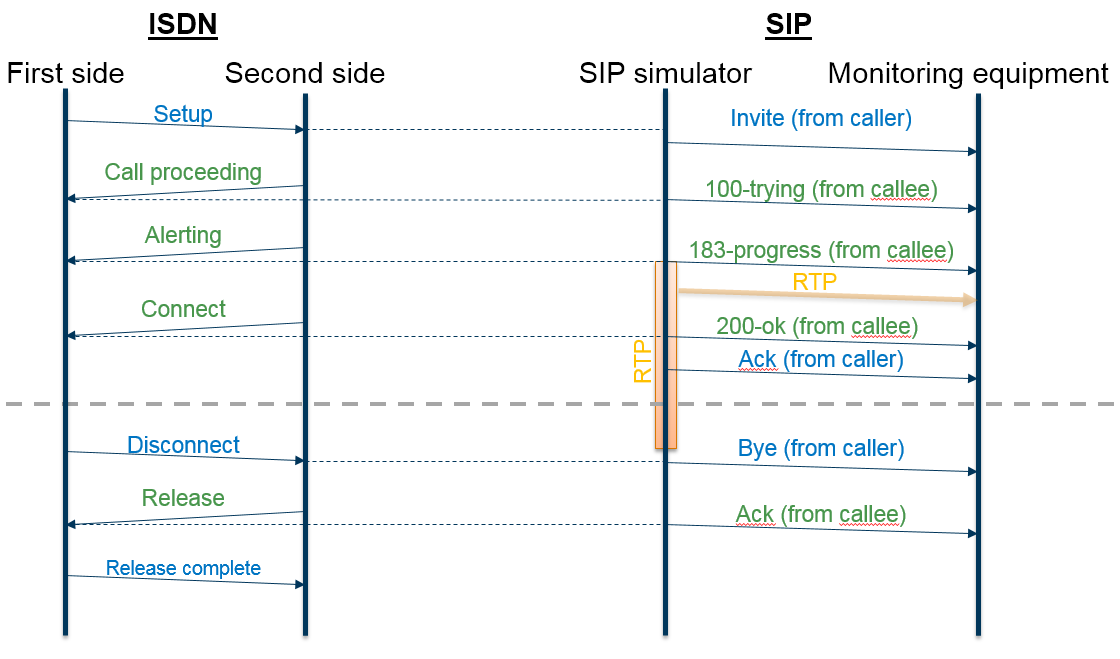Toolpack monitoring sip simulator
The Toolpack Monitoring "Sip Generator" is a behavior that can be attached to a call flow, and that will send simulated SIP messages to a destination host, simulating that a SIP calls is being monitored.
The SIP simulator sends SIP messages, but does not expect any reply from the destination. It simulates both sides of the SIP call (simulating a sip "Invite" from one side, then "100-Trying" from the other side, etc.)
It also sends a copy of the monitored legs audio using RTP packets, as indicated in the SDP of the simulated SIP message (Invite, 183-Progress and 200-OK).
Contents |
SIP simulator call flow
Once attached to a call flow, the "sip simulator" behavior will identify the "main" legs of the attached call flow (one incoming and one outgoing), and watch for call state changes of these legs. Corresponding SIP messages are generated.
Attaching to a monitoring call flow
The SIP simulator behavior can be attached to a standard call flow (CTBCAFBrige for example, which deals with a bridge between one incoming and one outgoing call legs).
It can also be attached to a "monitoring" call flow that receives call state change events from an analyzer (like an ISDN Analyzer).
In both cases, it will generate SIP messages based on the call state changes event received (call accepted, alerting, answered, etc...)
SIP simulator configuration
The SIP simulator has multiple options that can be configured (from it's "parameters" class for developers, or from the Web Portal for Toolpack Gateway users).
RTP generation options
The Sip simulator will send RTP packets that contain a copy of the audio of the monitored call. These RTP packets are sent by a VOIP resource on the TMedia unit.
RTP generation options are:
- The VOIP Media NAP to generate RTP from. This NAP defines:
- The source IP interface, and port range to use
- A default "profile"
- A "profile" to use instead of the NAP's default profile. The profile will define:
- The codec to use (the SDP)
- The DTMF relay scheme (Note: only "in-band" and "RFC-2833" being available with the "SIP simulator")
- Note: The "SIP" options available in the "profile" page in the web portal are ignored here
- Audio options (volume control, voice activity detection)
- RTCP options
- IP header "TOS" field
SIP generation options
The "SIP Simulator" will send SIP packets from the application using the following options:
- Source "host" IP interface (or "ANY" to choose by subnet matching or default gateway)
- Source UDP port
- IP header "TOS" field for SIP packets
SIP messages formatting
The "SIP Simulator" offers configurable SIP messages content, which will be used when necessary by the "SIP Simulator"
- The simulated "from" IP address and port (can be "fictive" IP address representing one "side" of the call)
- The simulated "to" IP address and port (can be "fictive" IP address representing one "side" of the call)
- The SIP message text of each SIP message, built using well-known variables
- From caller:
- SIP INVITE
- SIP ACK (after the INVITE 200 OK)
- SIP BYE
- SIP CANCEL
- SIP 200 OK (after BYE)
- SIP ACK (after 487)
- From callee:
- SIP 100 Trying
- SIP 183 Session Progress
- SIP 200 OK
- SIP Decline
- SIP BYE
- SIP 200 OK (after BYE or CANCEL)
- SIP 487 Request Terminated
- From caller:
For more information about available variables used to generate the SIP messages (SIP headers and body), read the following article: SIP Simulator messages formatting variables
